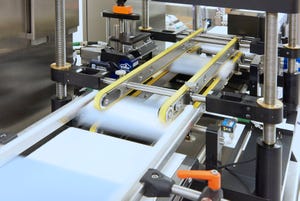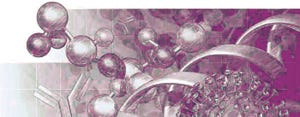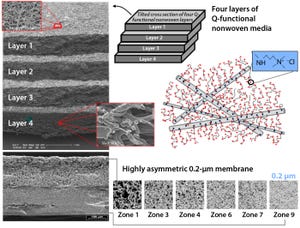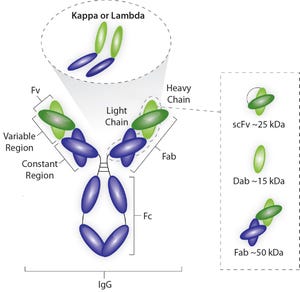with Daniela Guttmann and Susanne Hall
Increasing regulatory requirements combined with the market pressure to develop patient-friendly drug delivery systems make product lifecycle management (PLM) a decisive field for today’s pharmaceutical and biotechnology companies. Their strategic service providers also are affected by those conditions. For example, as an internationally operating contract development and manufacturing organization (CDMO), Vetter reports an increasing number of life-cycle management projects with its
customers in the past years.
Learn more in this white paper from Vetter.
More often than we realize, industry literature suffers from discrepancies in definitions of (seemingly) common, basic terms. We have pointed this out before — twice addressing the differences between
analytical
and
bioanalytical
testing, for example, and cautioning against misunderstanding the distinctions. Some terms are interchangeable, though, or it may be too soon to separate them from one another (e.g., cell therapies and therapeutic vaccines).
We editors accept much of this as normal. Differences in interpretation will persist, and often a general point can be made without delving into their minutiae. But determinations of the fledgling biotech industry 25 years ago may need occasional dusting off and revisiting. Distinctions understood by the first wave of modern bioprocessors may be accepted by those new to the industry without the critical lower-iceberg foundation of historical knowledge. As biotechnology enjoys greater public awareness — and as patients, providers, and investors rely on the...
BioProcess Development Week 2015
by Maribel Rios
From 30 March to 2 April 2015, more than 750 professionals gathered at the Hyatt Regency Resort in Huntington Beach, CA, to attend the annual Biopharmaceutical Development and Production meeting. Organized by IBC Life Sciences, BDP Week provided attendees with keynote addresses and sessions on the state of the bioprocessing industry and hot technical topics as well as preconference workshops, exhibit hall networking opportunities, poster presentations, and keynote addresses from five bioindustry leaders.
Karol Lacki, PhD (GE Healthcare Biosciences) kicked off the conference by introducing three keynote speakers: Dana C. Anderson (Genentech, a Member of the Roche Group), Uwe Gottschalk (Lonza Pharma/ Biotech), and Anthony Davies (Dark Horse Consulting). The first discussed how breakthrough therapies could be a key factor in making bioprocesses more efficient. Chemistry, manufacturing, and controls (CMC) activities can be a challenge, and companies need to ac...
https://bioprocessintl.com/wp-content/uploads/2015/06/062015-SumenMcIntyre.mp3
WWW.GRAPHICSTOCK.COM
In part 1 of this two-part series, we outlined common challenges of technology transfer that are unique to the cell therapy industry and discussed strategies for success (
1
). Here, we delve even further into best practices and highlight key strategies for technology transfer that should be considered along the path to success. Creating a strong foundation for technology transfer will streamline clinical manufacturing processes and help position therapeutic products for long-term success. Below are key criteria for success.
Confirm Transfer Acceptance Criteria
Creation of a program charter is a perfect place to start discussions about acceptance criteria for activities to be performed during the course of a project. Acceptance criteria help you ascertain whether an ongoing technology transfer is successful at a given time. An absence of clear acceptance criteria before an activity leads to misaligned expec...
In the fall of 2004, the US Food and Drug Administration (FDA) published a final report entitled
Pharmaceutical CGMPs for the 21st Century: A Risk-Based Approach
(
1
). This publication set the groundwork for a prospective risk‑based approach to pharmaceutical product development. It was published on the heels of a November 2003 agreement between the FDA and the International Conference on Harmonisation of Technical Requirements for Registration of Pharmaceuticals for Human Use (ICH) to develop an internationally harmonized plan for developing a pharmaceutical quality system based on an integrated approach to risk management and science. Integral to a quality‑based system that is rooted in science and risk management is the concept of quality by design (QbD). It is a systematic approach to drug development that begins with predefined objectives and emphasizes product and process understanding and process control based on sound science and quality risk management (
2
).
Since 2004, a number of working gr...
by John Otrompke, with Cheryl Scott and S. Anne Montgomery
When the United States Food and Drug Administration (FDA) approved the country’s first ever biosimilar on 6 March 2015, it had been a long time coming. After all, the European Union had approved the first biosimilar in 2006, and a number of others have followed in Europe since then. Still, the approval of biosimilar filgrastim, a recombinant colony-stimulating factor used to offset the complications of chemotherapy, was a welcome step forward for the biosimilars segment of the biopharmaceutical industry.
Amgen had sold the reference product in the United States since 1991 and enjoyed more than US$1 billion in sales in 2014. The biosimilar approval was considered by many to be good news both for Sandoz (a Novartis company, which developed it) and for patients and their insurance companies, who could expect to enjoy savings compared with the price of the reference product (Amgen’s Neupogen).
However, this first American biosimilar approval also ill...
WWW.PHOTOS.COM
Potency is a critical quality attribute to support development and release of biopharmaceutical products. Researchers assess most protein-drug potencies using biological assays (such as cell-based assays), which mimic a product’s known mechanism of action or binding assays (if the only known mechanism of action is a drug binding to its target or if a drug is in early phases development). Potency denotes an important feature of complex biologics: their biological activity produced as a direct result of the molecule’s tertiary/quaternary structure.
Biological assays have a number of potential applications. These include drug release, stability testing, standard and critical reagents qualification, characterization of process intermediates, formulation, product contaminants/degradation, and support for production (
1
). So the potency-test requirements and assay format depend on a given product’s intended use. Therefore, it is crucial to correctly evaluate protein drugs’ assay characteristics ...

 +3
+3https://bioprocessintl.com/wp-content/uploads/2015/06/052015_Allen-optimization.mp3
PALL LIFE SCIENCES (WWW.PALL.COM)
In multistep schemes, hydrophobic charge-induction chromatography (HCIC) has been shown to contribute effectively to clearance of Chinese hamster ovary (CHO) host-cell proteins (CHOPs), DNA, and viruses. When used for capture chromatography, HCIC can provide better aggregate clearance than protein A sorbents can. Chen et al. enhanced clearance of aggregates, CHOPs, and product- related impurities by controlling HCIC based on both pH and the presence of binding-promoting salt in the wash and elution buffers used (
1
). Taken together with our findings presented herein, published results suggest that HCIC could play a broader role in monoclonal antibody (MAb) platform development.
Part 1 of this report
(
2
) provided background and described materials and methods used in our study of MEP HyperCel HCIC sorbent. Here, we conclude by discussing the results of 13 experiments, numbered according...

 +3
+3WWW.PHOTOS.COM
Protein concentrations in bioprocessing are determined by multiplying the measured absorbance of UV light as it passes through a sample by the protein extinction coefficient. Conventional spectrophotometer measurements are based on a fixed pathlength depending on the cuvette used to hold the sample (typically 10 mm). Only a small portion of the UV curve is linear at that pathlength. As a result, conventional spectrophotometers have a limited linear range and are unable to measure a large range of protein concentrations reliably without dilution of a sample to within linear range.
We used a SoloVPE variable pathlength spectrophotometer (from C Technologies, Inc.) in this study. Such instruments automatically adjust the optical pathlength from 0 mm to 15 mm in 5‑µm increments. They can determine the appropriate pathlength and linearity at significantly higher sample concentrations than those determined by fixed‑pathlength spectrophotometers. Pathlength scanning technology makes that capabilit...

 +2
+2Monoclonal antibodies (MAbs) are the most prominent and successful therapeutic proteins in the pharmaceutical industry. More than 35 MAbs have been approved to treat a range of conditions, and hundreds more are in development (
1
,
2
). Once, the upstream cell culture process was considered the bottleneck to producing high antibody doses required for treatment, but recent advances in cell culture technology have boosted antibody titers to the range of 5–10 g/L (
3
). That increase in productivity has shifted focus onto downstream antibody purification bioprocess development (
1
,
4
). In addition to advancements in cell- line development, the now-typical higher antibody titers have been achieved by optimizing cell culture media and growth conditions, which increases cell culture density and lengthens culture duration. That translates into higher levels of process-related impurities such as host-cell proteins (HCPs) and DNA, lipids, colloids, and cell debris (
1
). The main goal of a downstream process (...

 +2
+2Compared with traditional approaches such as chemotherapy and radiotherapy, monoclonal antibodies (MAbs) have become the most successful cancer treatments in the past 20 years (
1
). With great clinical success in many therapeutic areas, MAbs now account for >40% of the entire biotechnology drug market, and sales are projected to be >US$160 billion over the next few years in the United States alone (
2
). More than 35 MAbs have been approved for clinical use, and hundreds more are filling industry development pipelines. As a therapeutic class, MAbs have proven to be very effective against autoimmune diseases as well, especially for cases in which targets are known and well defined.
Figure 1: Average sizes of Fab, dAb, and scFv antibody fragments, each of which has a kappa light chain that binds protein L without interfering with the antigen-binding site
Structurally, MAbs are monospecific antibodies: Y-shaped multidomain proteins with two light chains (kappa or lambda) and two heavy chains (Figure 1). New...
In an era of US$1,000/dose medications, a new approach may be needed to finance an emerging breed of expensive but highly effective pharmaceuticals and vaccines, according to a new Rand Corporation analysis. In other industries, it is common for suppliers to encourage customer investment — particularly for costly capital purchases such as new automobiles and machinery — through approaches such as equipment leases or supplier-financed credit. The healthcare industry could learn from such approaches.
For example, instead of paying up front for the cost of a treatment — $20 billion to vaccinate Brazil’s 203 million people against dengue fever, for example — a health system could issue debt instruments to the manufacturer. Those instruments could be structured as bonds, as mortgages, or as lines of credit. Terms and interest rates would vary.
This concept is not unprecedented, even in the healthcare industry. When hospitals need expensive equipment, they might lease it, or the supplier might offer a financial...














